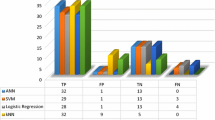Abstract
Molecular level diagnostics based on microarray technologies can offer the methodology of precise, objective, and systematic cancer classification. Genome-wide expression patterns generally consist of thousands of genes. It is desirable to extract some significant genes for accurate diagnosis of cancer because not all genes are associated with a cancer. In this paper, we have used representative gene vectors that are highly discriminatory for cancer classes and extracted multiple significant gene subsets based on those representative vectors respectively. Also, an ensemble of neural networks learned from the multiple significant gene subsets is proposed to classify a sample into one of several cancer classes. The performance of the proposed method is systematically evaluated using three different cancer types: Leukemia, colon, and B-cell lymphoma.
Similar content being viewed by others
References
Harrington CA, Rosenow C, Retief J (2000) Monitoring gene expression using DNA microarrays. Curr Opin Microbiol 3:285–291
Eisen MB, Brown PO (1999) DNA arrays for analysis of gene expression. Methods Enzymbol 303:179–205
Dudoit S, Fridlyand J, Speed TP (2000) Comparison of discrimination methods for the classification of tumors using gene expression data, technical report 576, Department of Statistics, University of California, Berkeley
Ben-Dor A, Bruhn L, Friedman N, Nachman I, Schummer M, Yakhini N (2000) Tissue classification with gene expression profiles. J Comput Biol 7:559–584
Zhou Z-H, Wu J, Tang W (2002) Ensembling neural networks: many could be better than all. Artif Intell 137(1–2):239–263
Scharpire RE (1990) The strength of weak learnability. Mach Learn 5(2):197–227
Breiman L (1996) Bagging predictors. Mach Learn 24(2):123–140
Zhou Z-H et al. (2002) Lung cancer cell identification based on artificial neural network ensembles. Artif Intell Med 24(1):25–36
Santos-Garcia G et al. (2004) Prediction of postoperative morbidity after lung resection using an artificial neural network ensemble Artificial Intelligence in Medicine
Abbass HA (2002) An evolutionary artificial neural networks approach for breast cancer diagnosis. Artif Intell Med 25:265–281
Futschik ME, Reeve A, Kasabov N (2003) Evolving connectionist systems for knowledge discovery from gene expression data of cancer tissue. Artif Intell Med 28:165–189
Cho S-B, Ryu J (2002) Classifying gene expression data of cancer using classifier ensemble with mutually exclusive features. Proc IEEE 90(11):1744–1753
Shamir R, Sharan R (2001) Algorithmic approaches to clustering gene expression data. In: Jiang T, Smith T, Xu Y, Zhang MQ (eds), Current topics in computational biology. MIT Press
Golub TR, Slonim DK, Tamayo P, Huard C, GaasenBeek M, Mesirov JP, Coller H, Loh ML, Downing JR, Caligiuri MA, Blomfield CD, Lander ES (1999) Molecular classification of cancer: Class discovery and class prediction by gene-expression monitoring. Science 286:531–537
Richard MD, Lippmann RP (1991) Neural network classifiers estimate Bayesian a posteriori probabilities. Neural Comput 3:461–483
Li J, Wong L (2002) Identifying good diagnostic gene groups from gene expression profiles using the concept of emerging patterns. Bioinformatics 18(5):725–734
Li L, Weinberg CR, Darden TA, Pedersen LG (2001) Gene selection for sample classification based on gene expression data: study of sensitivity to choice of parameters of the GA/KNN method. Bioinformatics 17(12):1131–1142
Furey TS, Cristianini N, Duffy N, Bednarski DW, Schummer M, Haussler D (2000) Support vector machine classification and validation of cancer tissue samples using microarray expression data. Bioinformatics 16(10):906–914
Li W, Yang Y (2000) How many genes are needed for a discriminant microarray data analysis, Critical Assessment of Techniques for Microarray Data Mining Workshop
Nguyen DV, Rocke DM (2002) Tumor classification by partial least squares using microarray gene expression data. Bioinformatics 18(1):39–50
Tamayo P (1999) Interpreting patterns of gene expression with self-organizing map: Methods and application to hematopoietic differentiation. Proc Natl Acad Sci USA 96:2907–2912
Hartuv E, Schmitt A, Lange J, Meier-Ewert S, Lehrach H, Shamir R (2000) An algorithm for clustering cDNA fingerprints. Genomics 66(3):249–256
Ben-Dor A, Shamir R, Yakhini Z (1999) Clustering gene expression patterns. J Comput Biol 6:281–297
Author information
Authors and Affiliations
Corresponding author
Rights and permissions
About this article
Cite this article
Cho, S.B., Won, HH. Cancer classification using ensemble of neural networks with multiple significant gene subsets. Appl Intell 26, 243–250 (2007). https://doi.org/10.1007/s10489-006-0020-4
Published:
Issue Date:
DOI: https://doi.org/10.1007/s10489-006-0020-4




